Routine lawn mower maintenance is extremely important for their overall longevity. There’s nothing worse than getting set up for a big mow session, and your lawn mower conks out a third of the way into the job.
When it comes to maintenance, it’s quite common to forget about treating problems such as water damage.
So, can lawnmowers get wet, though?
In general, a lawn mower can succumb to a little moisture but can not become soaked. A little rain won’t cause any damage as long as a few maintenance measures are taken once the job is complete.
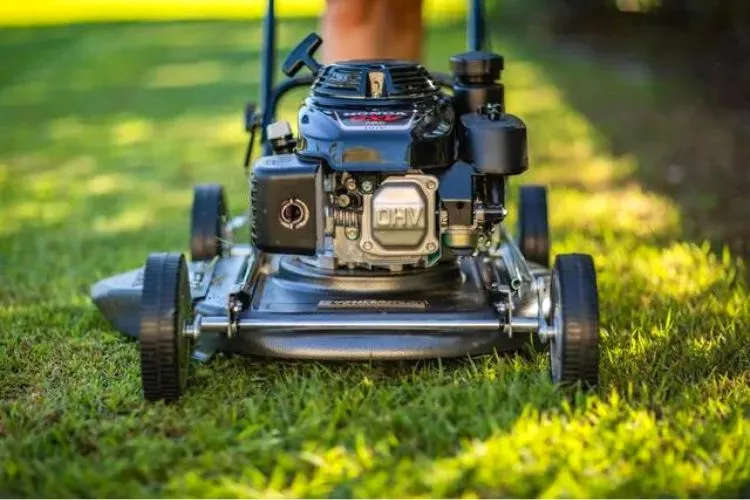
Furthermore, a few steps and tips can be followed to help minimize any damage caused. In this article, we’ll go through how lawnmowers work, what parts can and can’t get wet, and how to minimize and prevent any damage caused. Let’s dive in, shall we?
Table of Contents
How lawn mowers work?
Most lawn mower models that we use today run by the force of an internal combustion engine. They can either run on 2 or 4 cylinders. Those that run on 2 cylinders use both gasoline and oil. The oil assists with lubrication.
4 cylinder variants run on gasoline alone but have their separate lubrication system. Then some electric models run on either battery or power from an outlet. These are generally referred to as rotary lawnmowers.
Rotary lawnmowers work by the fuel source, creating internal combustion. The horizontally spinning base blade is attached to a vertical cog driven by the motor.
This makes the blades spin around at such a pace that they can cut the grass without any issues.
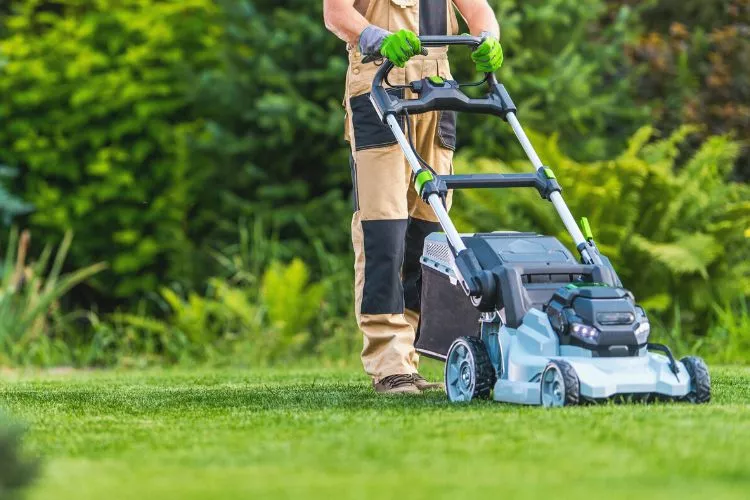
A throttle is usually attached to the handle where the mower is pushed or driven. The throttle can be adjusted to allow more or less fuel to enter the mower and become usable to adjust the speed at that the motor can be driven.
Some of the newer models have a self propelling function. This allows the mower to be trusted forward automatically by pressing a latch or handle that keeps the throttle on until it is released again.
Furthermore, cable pull start or push button types depend on the model.
Can lawnmowers get wet? (The Answer)
Lawnmowers are delicate in that all of their parts need to be well maintained to run efficiently during each use. When any part under the main deck (where the blade is located) becomes worn by rust via moisture damage, they simply break down and deteriorate over time.
Rust eats away at all of the metal parts and causes them to fall apart.
That’s not to say that they cannot be subject to any form of moisture because it’s almost impossible to predict the condition of grass during a range of weather outcomes.
Of course, it’s not ideal for cutting the grass when wet, but sometimes, it’s difficult to avoid.
The best way to keep your lawn mower in optimal condition is to ensure it doesn’t get completely soaked. Additionally, if it is exposed to any moisture, it’s best to ensure that all parts under the deck are cleaned and dried after each use.
What Parts of the Lawn Mower Can Get Wet?
If your lawn mower does happen to be exposed to moisture, it’s generally no real cause for concern. As long as certain parts remain dry or are carefully maintained, you shouldn’t have any long-term problems.
However, some parts of the lawn mower need to stay dry not only for their longevity but also for the ability to start and run every time. Let’s have a look at these parts in a little more detail.
The spark plug
Spark plugs are designed to create a spark that ignites the combustion engine, which essentially starts any vehicle, including a lawn mower. The spark of electricity crosses a small void to ignite a fuel and air mixture.
This spark allows the pistons to start and essentially run the engine. So, when a spark plug becomes moist, it is difficult to create that spark. As a result, the lawn mower struggles to get started.
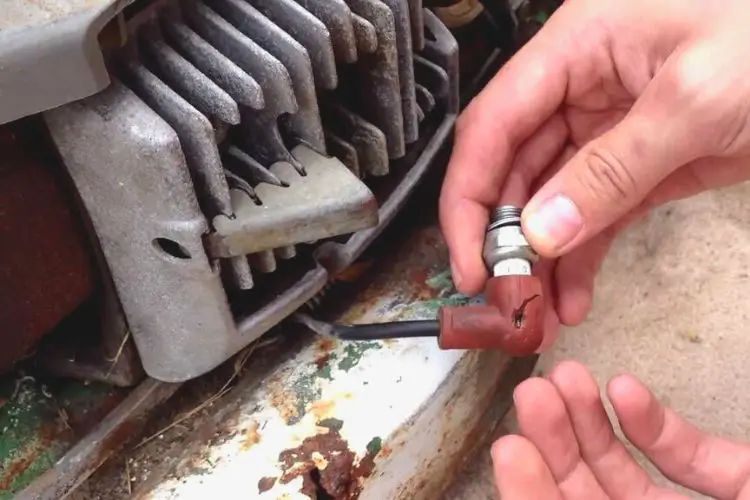
The air filter
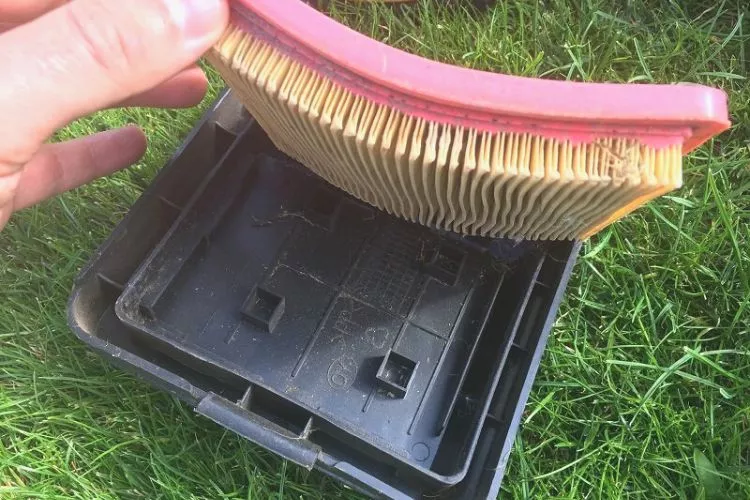
When an air filter becomes moist, it reduces its ability to suck air in to assist with combustion. Engines require an air and fuel combination to ensure the engine runs efficiently.
A dry, well maintained air filter will also prevent outside debris, such as insects, dust, particles, and sand, from reaching and clogging up the engine.
The carburetor and fuel tank
Carburetors control and distribute the air and fuel combinations required for an engine to run effectively and efficiently. When exposed to water or moisture, it restricts the carburetors ability to control the flow. As a result, the engine won’t receive what it needs to run or start up.
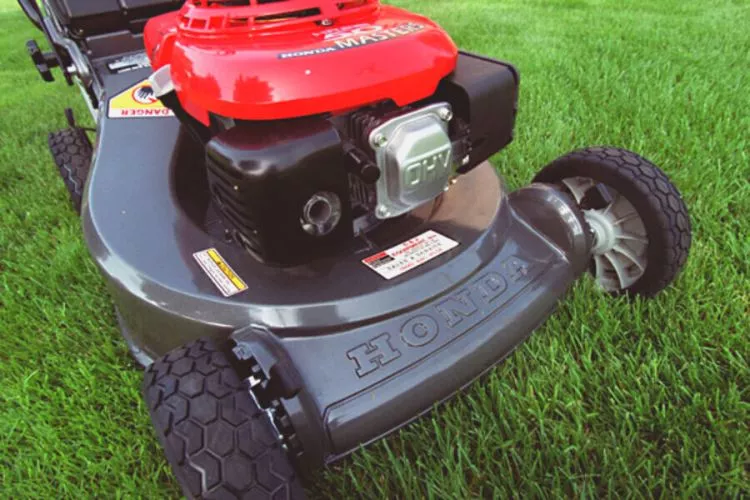
When water or even small amounts of moisture enter a fuel tank, it doesn’t allow the fuel injectors to do what they are designed to do. As a result, the engine will chug, often leading to internal explosions. Water simply cannot compress in the cylinder of an engine.
Other Parts (The deck, wheels etc)
The deck, wheels, pins, and other lesser important parts can be exposed to some moisture. However, if these parts are not maintained, they can be susceptible to rusting, corrosion and other manageable but inconvenient damages.
These parts are a little easier to fix, but it’s still not worth the hassle when a big job is at hand.
Why is it not recommended to get a lawn mower wet?
Mowing your lawn is one of those mundane tasks that you just tune out to and work through in an organized manner. You go through the standard procedures without thinking too much about the condition of the grass.
Maintaining the lawn mower isn’t always at the top of the agenda after a long mow session, either, especially if it’s been a wet mow. You just want to power down, roll on into the garage or shed, pack up and walk away.
However, it’s not always a good idea to power through when the grass is too wet. Several problems can occur. These include:
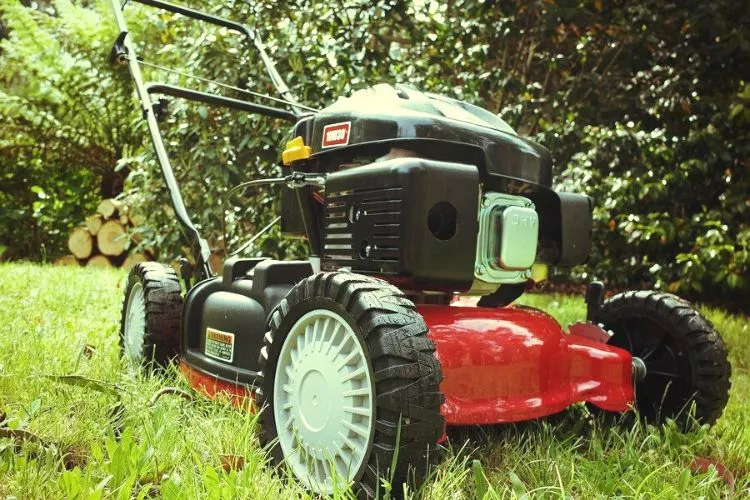
Water damage
Water can damage the engine and electrical components of a lawn mower and cause short circuits. Most of the newer lawn mower models contain electrical components that prevent the lawn mower from even starting if they are exposed to moisture. They are usually located on the handle and connect down to the engine.
Thankfully, the designers have ensured that these parts are as protected as they can be, but there is always the risk of becoming damaged.
Especially if it starts to rain midway through a mowing session, and you’re too proud to pull up and wait it out.
Short circuiting your lawn mower is the last thing you want to happen. It’s inconvenient to go and get it serviced when the problem could have more than likely been avoided.
Rust and corrosion on metal parts
Rust and corrosion usually affect the lower regions of the lawn mower. Anything in and under the deck, such as the blade, wheels, pins, etc., is most at risk. It’s recommended that a lawn mower is stored in a dry, covered area once works are complete.
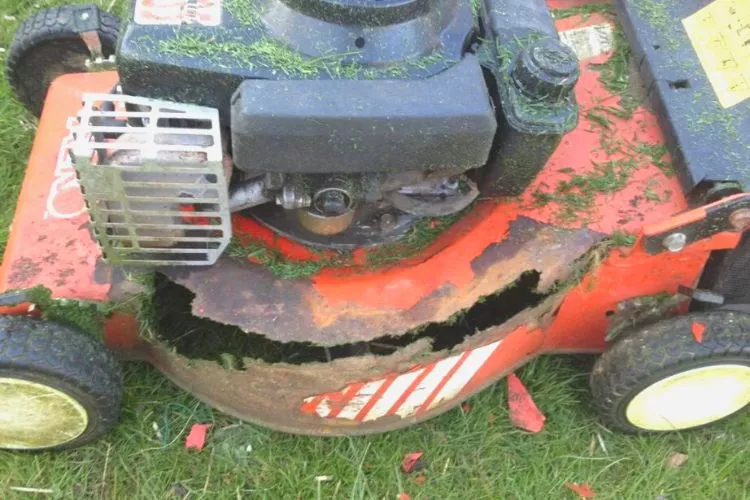
This will allow any moisture to dry out. Furthermore, it can be worth giving all of the lower areas a bit of a wipe off with a dry rag after a mow session to minimize any build up of mold. Try to brush away any wet grass, leaves or other organic debris, as these are prime causes of forming mold.
Difficulty starting the engine after it has been wet
When the spark plugs become damp, it becomes difficult to create the initial spark needed to ignite the engine. It’s plain and simple; avoiding excessive amounts of water where possible is good practice.
Damage to the air filter and carburetor
The air filter and the carburetor are essential to ensuring that an engine receives air and fuel from making it run effectively. When these 2 parts are exposed to even minor amounts of moisture, their function can become severely hampered.
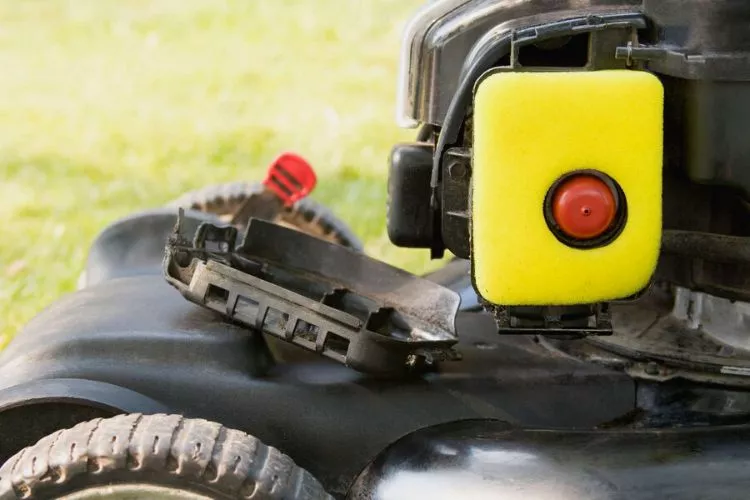
The air filter cannot suck in an optimal amount of air, and the carburetor cannot control the flow of the air and fuel combination. As a result, the engine won’t be able to start or run as it is designed to.
When is it necessary to get a lawn mower wet?
A little moisture exposure is generally not a big deal for lawnmowers. After all, they are designed as outdoor equipment, so their parts are somewhat protected. Furthermore, it’s not always 68 °F (20°C), the wind still and clear blue skies when you’re cutting grass.

Sometimes, it’s unavoidable for a lawn mower to become wet. These moments include:
Cleaning the mower deck and blades
You’re always excused from a little moisture when cleaning the deck and blades of a mower. Especially considering that it’s a core pillar of mower maintenance.
One of the best ways to give the underside of your mower deck a deep clean is by tilting it up to expose all of the parts and using a pressure washer to spray away anything that shouldn’t be there.
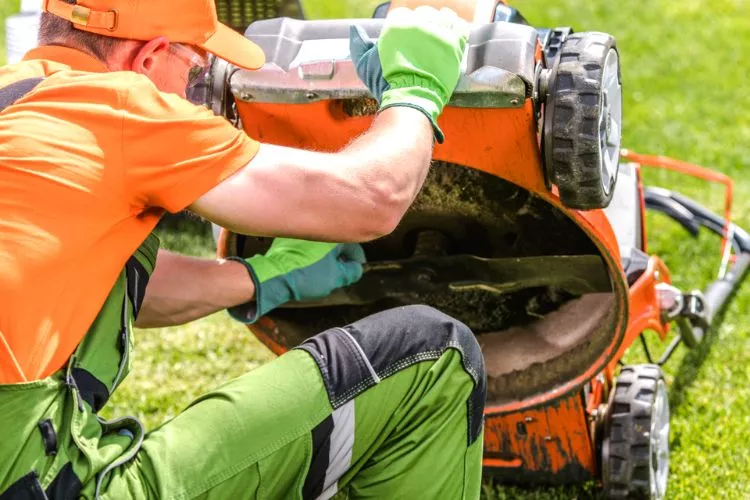
This includes grass, leaves, branches or any other organic debris. A normal hose can also do the job but may take more elbow grease. Always use a rag or paper towel to dry the deck out once it is clean unless it is stored somewhere dry and warm where it can dry without assistance.
Removing built-up grass clippings and debris
Cleaning the top and outside of your mower is done similarly to the deck and blade. Give it a good spray to remove built-up grass clippings or other organic debris to keep it fresh and minimize the risk of mold forming. Again, always dry your mower off once the cleanup is complete.
Cooling the engine during prolonged use
Sometimes when the lawn mower has been used for long periods, it can be too hot to clean away. In this case, it’s wise to allow it to cool down before cleaning it up.
During this cool down period, there’s no problem with leaving it a little wet. The general rule is to keep it dry where necessary but also do the required work, cleaning up and drying once complete.
How to Prevent water damage to lawn mowers?
It’s impossible to predict what the weather is going to do. You can be set for a big mowing session on a beautiful day, and it all changes instantly. The grass you’re attempting to mow can also be completely soaked without you knowing.
When a mower is subject to some moisture, the best action is to get it undercover and assess what action to take next. Alternatively, there are some preventative measures that you can take to protect and minimize any potential damage. Here are some simple tips you can use:
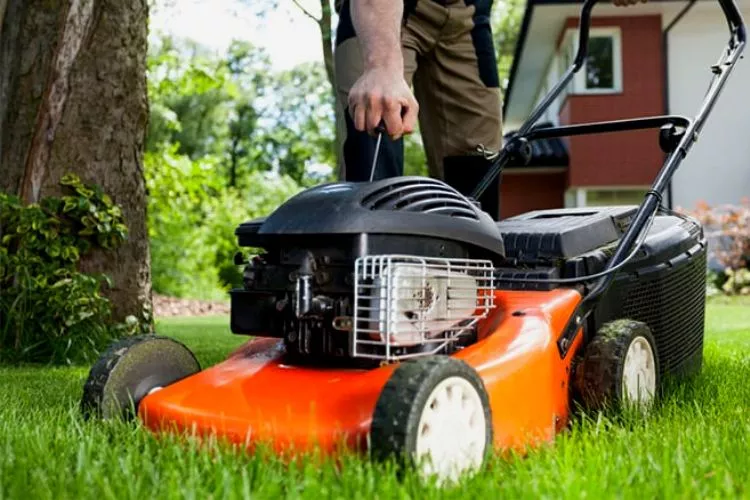
Assess the area/Avoid rain
The first piece of preventative action that you can take is to assess the area you are mowing. Have a good look around to decide if the grass is too long and wet. The longer the grass, the more moisture will be held. Long grass can also hide puddles, rocks and other obstacles that can cause further damage or injury.
If the grass seems dry enough, keep an eye on the weather. If you know there will be heavy rain on the day, avoid mowing. Aim to give the grass 2-3 days to dry before mowing.
Use a waterproof cover
There are some waterproof covers that can be used whilst mowing; they help to protect the mower from damage caused by rain or wet grass. Make sure that they are approved for use whilst driving, though.
Otherwise, when it comes to storage, use these covers once you complete your work to protect them from any additional moisture the mower may be exposed to.
Correct Storage
Storing your lawn mower in a dry, undercover area such as a garage or shed is essential. Avoid letting them sit outside on grass where they can be exposed to a heap of moisture. Clean away grass clippings after use and dry all areas with a clean rag as best as you can upon storage.
Maintenance
Adequate cleaning falls in the maintenance category. Once you complete any mowing, clean away any built-up grass, leaves or other organic matter. Use a hose or pressure washer to give the underside of the deck a good flush out.
Continue with the top and outside before drying away any moisture. Fill up fuel and oil once you have cleaned the mower up, and store in a dry, undercover area.
How to minimize damage if a lawn mower gets wet?
If your lawn mower does happen to get wet, it’s usually not too much of a problem. It only becomes an issue if the whole engine is submerged in or flooded by water.
Even then, giving it a good dry out will allow it every possible chance to recover. You can take a few steps to minimize any damage caused by exposure to water.

Dry off the mower as soon as possible after it gets wet
Regardless of the ground conditions, give the mower a good dry once you have finished mowing. Use rags or an air compressor to remove as much moisture as possible. Be extremely thorough and try to get into any hard to reach places. This will minimize the risk of any mold, rust or corrosion forming.
Disconnect the spark plug and remove the air filter before cleaning
Always disconnect and remove the spark plug and air filter whilst cleaning. These tasks don’t take much effort and protect them from being exposed to any stray moisture that can fly around whilst giving the mower a clean up.
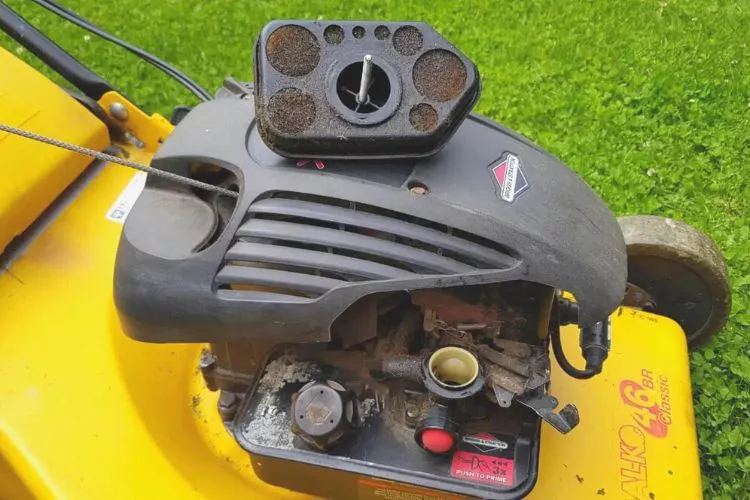
The spark plug ignites the engine, and the air filter draws in air to help the engine with combustion. Ensuring that these parts are not hindered by moisture is essential to the overall management and state of the mower.
Use a rust inhibitor to protect metal parts
Rust inhibitors should be used when going through every maintenance check. Even if you manage to dry away all the moisture, rust can still form and spread unannounced. Giving all metal parts a simple spray or ‘lube up’ can help lengthen their life quite a bit.
Use a waterproof cover or tarp to protect the mower
Waterproof covers are constantly being improved as we speak. These days you can purchase covers that allow the mower to be used whilst protected via the cover. Otherwise, simply throwing a good quality lawn mower cover over your mower after being cleaned up will protect it from any further water damage whilst not in use.
Frequently Asked Questions (FAQs)
Can Electric Lawn Mowers Get Wet?
All lawnmowers are designed to be able to withstand some water. So yes, electric mowers can get wet. However, they should never be submerged in higher volumes of water. Electric mowers can short circuit if their components aren’t maintained once exposed to moisture. Furthermore, any extension cables or batteries can become damaged if left out in the rain or even in a puddle of water.
Can lawnmowers be left outside?
Yes, but it’s not recommended if there is rain forecasted for the duration of its storage outside. Lawnmowers are best stored undercover to prevent any water damage. If this cannot be achieved, then using a waterproof cover is a great option.
Conclusion:
It’s safe to say that lawnmowers can be exposed to water but not so much that it causes damage to electrical components, spark plugs, air filters, carburetors, etc. Most newer lawn mower models are designed so that these parts are generally protected.
As long as regular cleaning (including adequate drying) and maintenance are performed, you will be giving your lawn mower the best chance at a long lasting and reliable lifespan.
We hope that this guide has been helpful. You can read about similar topics here on our website. Check back again soon for more.


